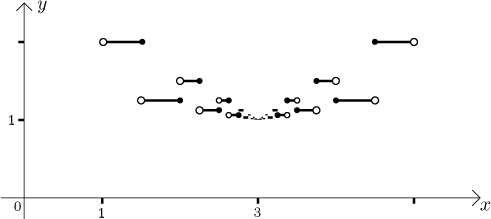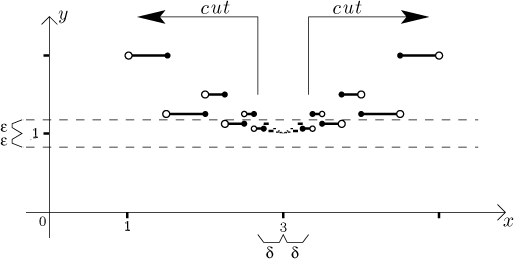Here we will construct a bit uglier function which has limit 1 as x
tends to 3. We will do it using similarity. The basic shape is two horizontal
segments with left endpoints filled as in the picture. Precisely, consider a
box of side one, draw a horizontal segment (with a filled endpoint on the
left, empty on the right) along its upper side, but only in the right half.
On the left half of this square, draw another such horizontal segment at
level 1/4 of its height. This will be the "basic box".
Now we start building the function. We start by imagining a rectangle
with horizontal side 2 and vertical side 1 attached to the point
(3,1) by its
lower left corner. Take the basic box and place it in the right half of this
rectangle:

The basic box filled the right half of the rectangle, the left half is left
empty. It is a square, when we look at its lower half, we see a rectangle
whose width and height have ratio 2:1, in fact its sides are exactly half the
size of the original rectangle. Thus we can repeat the first step, just with
everything scaled down. We take the basic box, scale it down twice and put it
into the right half of the smaller rectangle.

We are left with the left half of the rectangle. Take its lower half, it is
again a 2:1 rectangle, and fill its right half with the basic box scaled down
four times. Keep going infinitely many times. Eventually we obtain a function
that is defined for all numbers from the interval (3,5). How do we know?
Pick any x > 3 (and
x < 5). If it is greater or equal to 4,
then in the first step we assigned a value to this x. Otherwise it is
in the left half of the starting rectangle. Since the sizes of rectangles
are halved at every step and we thus keep moving the right side toward 3,
sooner or later the right side will pass our x. When we look at the
immediate step before this, x will be exactly the right half of the
corresponding rectangle and therefore it was assigned a value at that step.
Anyway, we have a function on (3,5). If we mirror it horizontally about the
line x = 3, we get a function defined on the set
(1,3) ∪ (3,5).

This domain includes a reduced neighborhood of
a = 3, in
fact it is one such neighborhood, so we can consider limit at 3 and we guess
that it is 1, since when we start approaching the point
a = 3 with arguments x, the corresponding values
eventually get as close as we want to the level 1. However, they definitely
do not go there in a nice way.
In the following picture we show one particular game of the epsilon-delta
battle.

Some experimenting should convince you that the game can be won no matter how
small the tolerance epsilon.




